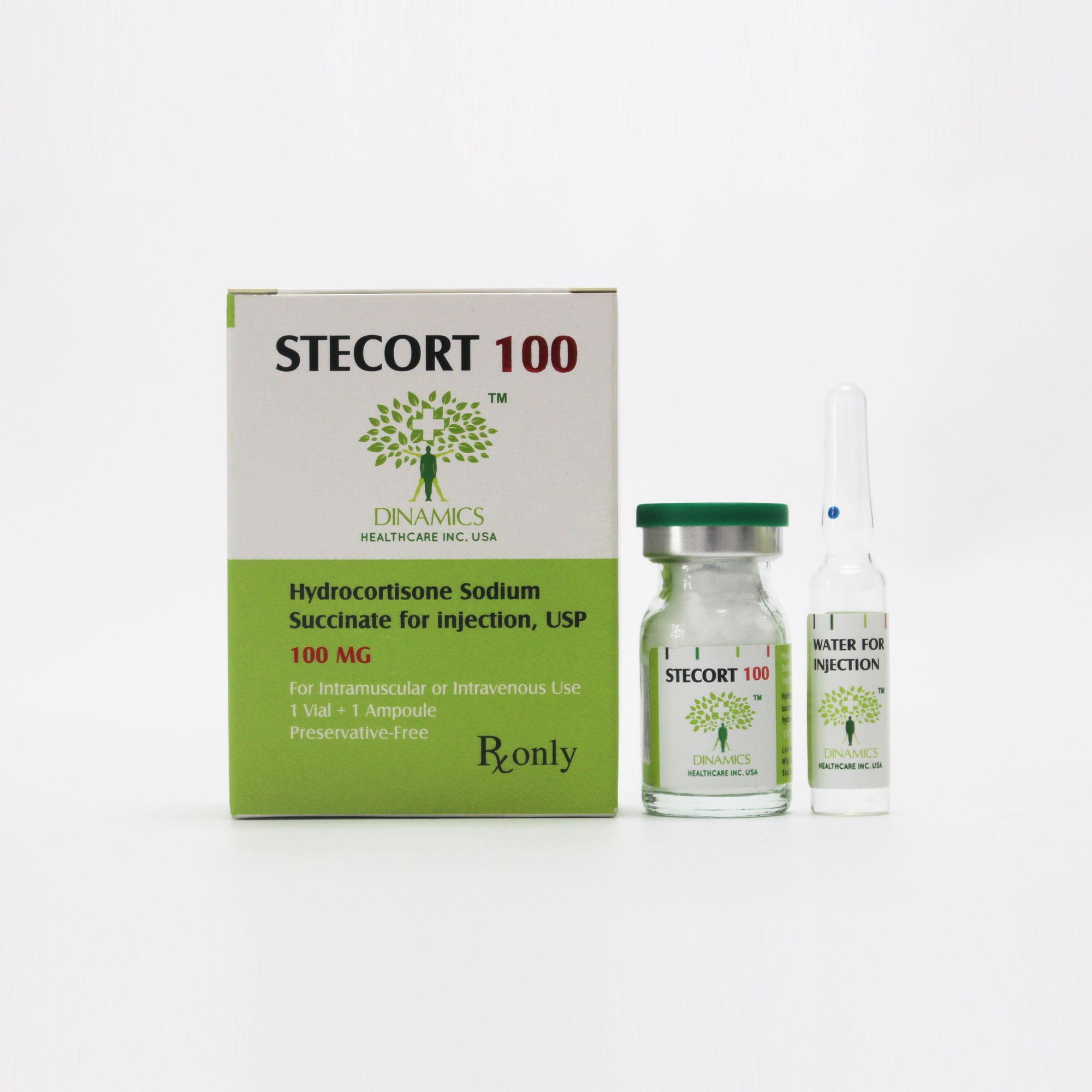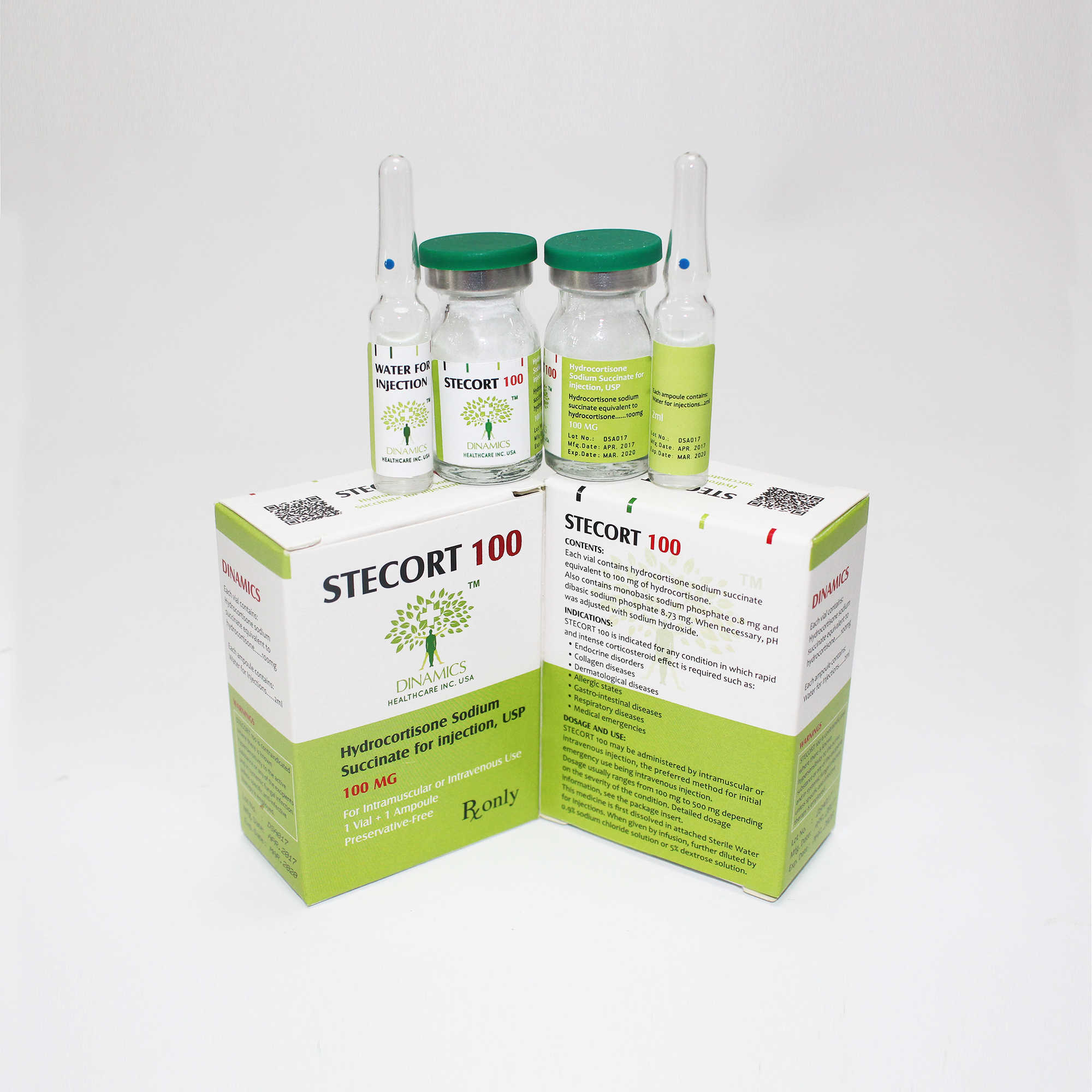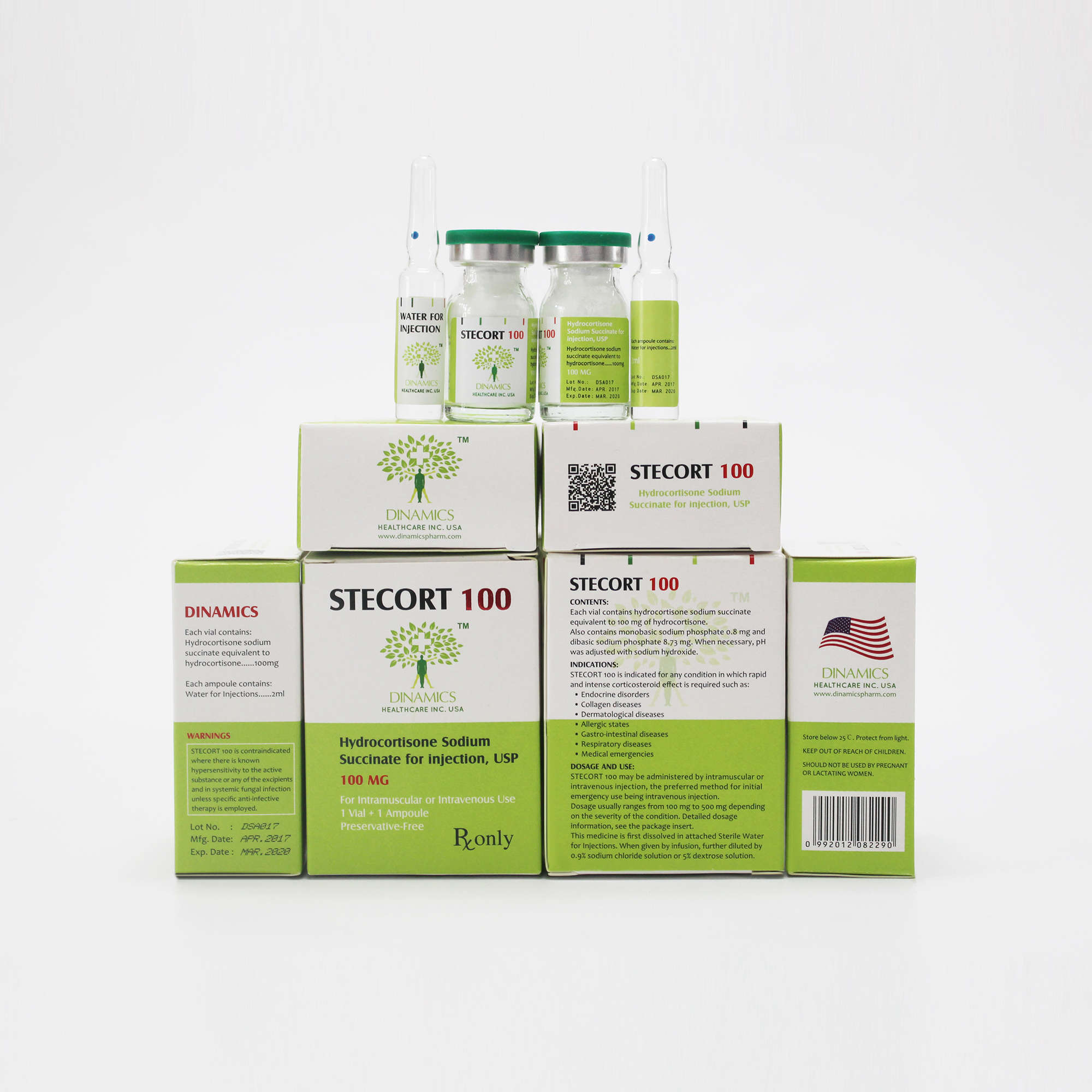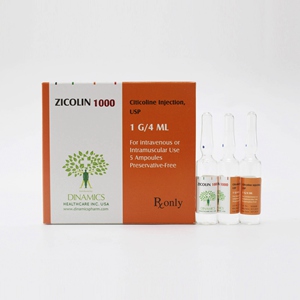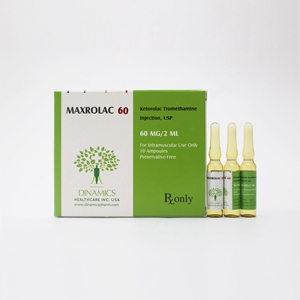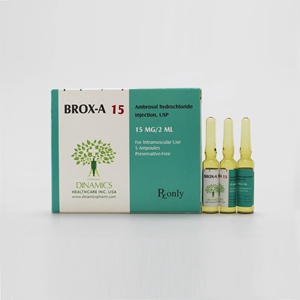Hydrocortisone Sodium Succinate for injection,
Contents of the pack and other information
What STECORT 100 contains
• Each vial of this medicine contains 134mg of Hydrocortisone Sodium Succinate (equivalent to100mg Hydrocortisone) as the active ingredient.
• The other ingredients are monobasic sodium phosphate and dibasic sodium phosphate.
What STECORT 100 looks like and contents of the pack
STECORT 100 is a white powder which comes in a clear glass vial fitted with a rubber cap and metal seal.
The pack contains a vial containing 100 mg hydrocortisone, also contains 1 ampoule containing 2 ml sterile water for injections.
DESCRIPTION
1. What STECORT 100 is and what it is used for
This medicine contains the active substance hydrocortisone, which belongs to a group of medicines called corticosteroids or steroids. Corticosteroids are produced naturally in your body and are important for many body functions. Hydrocortisone is indicated for any condition in which rapid and intense corticosteroid effect is required such as:
• Endocrine disorders
Primary or secondary adrenocortical insufficiency
• Collagen diseases
Systemic lupus erythematosus
• Dermatological diseases
Severe erythema multiforme (Stevens-Johnson syndrome)
• Allergic states
Bronchial asthma, anaphylactic reactions
•Gastro-intestinal diseases Ulcerative colitis, Crohn's disease
•Respiratory diseases Aspiration of gastric contents
•Medical emergencies
Hydrocortisone is indicated in the treatment of shock secondary to adrenocortical insufficiency or shock unresponsive to conventional therapy when adrenocortical insufficiency may be present.
2. What you need to know before you take STECORT 100 Do not use STECORT 100 if:
•You think you have ever suffered an allergic reaction, or any other type of reaction after being given STECORT 100, or any other medicine containing a corticosteroid, or any of the ingredients in this medicine. An allergic reaction may cause a skin rash or reddening, swollen face or lips or shortness of breath.
•You have any fungal infection (such as thrush) which is not being treated.
•You must not have ‘live’ vaccines while using this medicine.
See your doctor immediately if you have any of the above. Take special care before taking STECORT 100:
You must tell your doctor before you take this medicine if you have any of the following conditions. Your doctor may also have to monitor your treatment more closely, alter your dose or give you another medicine.
•Chickenpox, measles, shingles or a herpes eye infection. If you think you have been in contact with someone with chickenpox, measles or shingles and you have not already had these illnesses, or if you are unsure if you have had them.
•Severe depression or manic depression (bipolar disorder). This includes having had depression before while taking steroid medicines like STECORT 100, or having a family history of these illnesses.
•Diabetes (or if there is a family history of diabetes).
•Epilepsy.
•Glaucoma (increased pressure in the eye) or if there is a family history of glaucoma.
•You have recently suffered a heart attack.
•Heart problems, including heart failure or infections.
•Hypertension (high blood pressure).
•Hypothyroidism (an under-active thyroid).
•Kaposi’s sarcoma (a type of skin cancer).
•Kidney or liver disease.
•Muscle problems (pain or weakness) have happened while taking steroid medicines in the past.
•Myasthenia gravis (a condition causing tired and weak muscles).
•Osteoporosis (brittle bones).
•Skin abscess.
•Stomach ulcer or other serious stomach or intestinal problems.
•Thrombophlebitis – vein problems due to thrombosis (clots in the veins) resulting in phlebitis (red, swollen and tender veins).
•Tuberculosis (TB) or if you have suffered tuberculosis in the past.
You must tell your doctor before you take this medicine if you have any of the conditions listed above.
Pregnancy, breast-feeding and fertility
You must tell your doctor if you are pregnant, think you might be pregnant or are trying to become pregnant as this medicine could slow the baby’s growth. Tell your doctor if you are breastfeeding as small amounts of corticosteroid medicines may get into breast milk. If you continue breast-feeding while you are having treatment, your baby will need extra checks to make sure he or she is not being affected by your medicine.
Driving and Using Machines
The effect of this class of medicines on the ability to drive or use machinery has not been studied. There are undesirable effects observed with the use of this medicine such as syncope (fainting), vertigo (sensation of rotation or movement of oneself or the surrounding), and convulsions (seizures). If you are affected by any of them, you should not drive or operate machinery.
DIRECTION
1.How to take STECORT 100 Dosage information
Your doctor will decide on the site of injection, how much of the medicine and how many injections you will receive depending on the condition being treated and its severity. Your doctor will inject you with the lowest dose for the shortest possible time to get effective relief of your symptoms.
Adults
STECORT 100 will be given as an injection by your doctor or nurse, either into a vein (intravenous) or into a muscle (intramuscular). Usually the first dose is given into a vein, especially in an emergency.
Dosage usually ranges from 100 mg to 500 mg depending on the severity of the condition, administered by intravenous injection over a period of between 1 – 10 minutes. Depending on your condition a repeat dose may be injected at intervals of between 2 to 6 hours. Large doses should normally be used for only two to three days.
The medicine is first dissolved in Sterile Water for Injections. If the medicine is to be given by infusion (using a pump or drip) it is then mixed with another suitable fluid. No other medicines should be mixed with it.
Elderly
Treatment will normally be the same as for younger adults. However your doctor may want to see you more regularly to check how you are getting on with this medicine.
Children
Corticosteroids can affect growth in children so your doctor will prescribe the lowest dose (normally not more 25mg a day) that will be effective for your child.
2. Possible side effects
Like all medicines, this medicine can cause side effects, although not everybody gets them.
In certain medical conditions medicines like STECORT 100 (steroids) should not be stopped abruptly, if you suffer from any of the following symptoms seek IMMEDIATE medical attention, your doctor will then decide whether you should continue taking your medicine:
•Allergic reactions, such as skin rash, swelling of the face or wheezing and difficulty breathing. This type of side effect is rare, but can be serious.
•Acute pancreatitis, stomach pain which may spread through to your back, possibly accompanied by vomiting, shock and loss of consciousness.
•Burst or bleeding ulcers, symptoms of which are severe stomach pain which may go through to the back and could be associated with bleeding from the back passage, black or bloodstained stools and/or vomiting blood.
•Infections. This medicine can hide or change the signs and symptoms of some infections, or reduce your resistance to the infection, so that they are hard to diagnose at an early stage. Symptoms might include a raised temperature and feeling unwell. Symptoms of a flare up of a previous TB infection could be coughing blood or pain in thechest. This medicine may also make you more likely to develop a severe infection.
•Pulmonary embolus (blood clot in the lung) symptoms include sudden sharp chest pain, breathlessness and coughing up blood.
•Raised pressure within the skull of children (pseudotumour cerebri) symptoms of which are headaches with vomiting, lack of energy and drowsiness. This side-effect usually occurs after treatment is stopped.
•Thrombophlebitis (blood clots or thrombosis in a leg vein), symptoms of which include painful swollen, red and tender veins.
If you experience any of the following side effects, or notice any other unusual effects not mentioned in this leaflet, tell your doctor straight away.
Blood, heart and circulation
•Problems with the pumping of your heart (heart failure) symptoms of which are swollen ankles, difficulty inbreathing and palpitations (awareness of heart beat) or irregular beating of the heart, irregular or very fast or slow pulse.
•Increased numbers of white blood cells (leucocytosis).
Body water and salts
•Swelling and high blood pressure, caused by increased levels of water and salt content.
•Cramps and spasms, due to the loss of potassium from your body. In rare cases this can lead to congestive heart failure (when the heart cannot pump properly).
Digestive system
•Nausea (feeling sick) or vomiting (being sick).
•Ulcers or thrush in the gullet (discomfort on swallowing).
•Indigestion.
•Bloated stomach.
•Persistent hiccups, especially when high doses are taken.
Eyes
•Glaucoma (raised pressure within the eye, causing pain in the eyes and headaches).
•Swollen optic nerve (causing a condition called papilloedema, and which may cause sight disturbance).
•Damage to the optic nerve or cataracts (indicated by failing eyesight).
•Thinning of the clear part at the front of the eye (cornea) or of the white part of the eye (sclera).
•Worsening of viral or fungal eye infections.
•Protruding of the eyeballs (exophthalmos).
•Blurred or double vision.
Hormones and metabolic system
•Slowing of normal growth in infants, children and adolescents which maybe permanent.
•Irregular or no periods in women.
•Increased hair on the body and face in women (hirsutism).
•Round or moon-shaped face (Cushingoid facies).
•Increased appetite and weight gain.
•Diabetes or worsening of existing diabetes
•Prolonged therapy can lead to lower levels of some hormones which in turn can cause low blood pressure and dizziness. This effect may persist for months.
•The amount of certain chemicals (enzymes) called alanine transaminase, aspartate transaminase and alkaline phosphatase that help the body digest drugs and other substances in your body maybe raised after treatment with a corticosteroid. The change is usually small and the enzyme levels return to normal after your medicine has cleared naturally from your system. You will not notice any symptoms if this happens, but it will show up if you have a blood test.
Immune system
• Increased susceptibility to infections which can hide or change normal reactions to skin tests, such as that for tuberculosis.
Muscles and bones
•Muscle weakness or wasting.
•Brittle bones (bones that break easily).
•Broken bones or fractures.
•Breakdown of bone due to poor circulation of blood, this causes pain in the hip.
•Torn muscle tendons causing pain and/or swelling.
•Muscle cramps or spasms.
Nerves and mood issues
•Feeling depressed, including thinking about suicide.
•Feeling high (mania) or moods that go up and down.
•Feeling anxious, having problems sleeping, difficulty in thinking or being confused and losing your memory.
•Feeling, seeing or hearing things which do not exist. Having strange and frightening thoughts, changing how you act or having feelings of being alone.
•Other nervous system side effects may include breathing problems, convulsions, dizziness, drowsiness, difficulty breathing, sensation of cold, heat or numbness, tinnitus or unconsciousness.
Skin
•Abscess, especially near injection sites.
•Acne.
•Poor wound healing.
•Thinning of skin with stretch marks.
•Bruising.
•Small purple/red patches on the skin.
•Pale or darker patches on your skin, or raised patches which are an unusual color.
If you experience any of the side effects listed above tell your doctor straight away.
INGREDIENTS
Contents of the pack and other information
What STECORT 100 contains
• Each vial of this medicine contains 134mg of Hydrocortisone Sodium Succinate (equivalent to100mg Hydrocortisone) as the active ingredient.
• The other ingredients are monobasic sodium phosphate and dibasic sodium phosphate.
What STECORT 100 looks like and contents of the pack
STECORT 100 is a white powder which comes in a clear glass vial fitted with a rubber cap and metal seal.
The pack contains a vial containing 100 mg hydrocortisone, also contains 1 ampoule containing 2 ml sterile water for injections.
STORE
How to store STECORT 100
STECORT 100 must not be used after the expiry date ‘EXP’ shown on the container.
The doctor or pharmacist will keep the medicine in a safe place where children cannot reach or see it.
Store below 25°C. Protect from light.
Once the medicine has been mixed with Sterile Water for Injections, the solution should be used straight away. Any unused liquid should be disposed of safely. Your doctor will check that the solution contains no particles and is not discoloured before using it.


